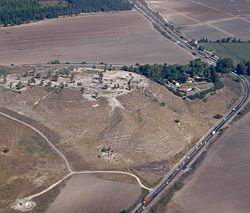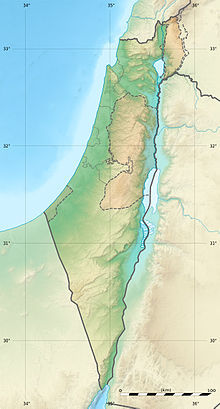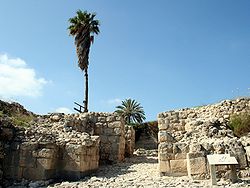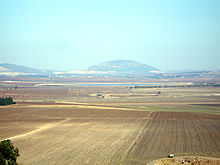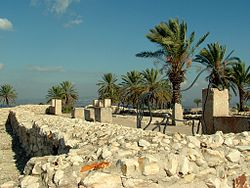- Tel Megiddo
-
Biblical Tells – Megiddo, Hazor, Beer Sheba * UNESCO World Heritage SiteCountry Israel Type Cultural Criteria ii, iii, iv, vi Reference 1108 Region ** Europe Inscription history Inscription 2005 (29th Session) * Name as inscribed on World Heritage List
** Region as classified by UNESCOMegiddo (Hebrew: מגידו; Arabic: المجیدو, Tell al-Mutesellim) is a tell in modern Israel near Kibbutz Megiddo known for its historical, geographical, and theological importance especially under its Greek name Armageddon. In ancient times Megiddo was an important city-state. Excavations have unearthed 26 layers of ruins, indicated a long period of settlement. Megiddo is strategically located at the head of a pass through the Carmel Ridge overlooking the Jezreel Valley from the west.
Contents
Etymology
Megiddo is also known as Greek: Μεγιδδώ/Μαγεδδών, Megiddó/Mageddón in the Septuagint; Latin: Mageddo; Assyrian: Magiddu, Magaddu; Magidda and Makida in the Amarna tablets; Egyptian: Maketi, Makitu, and Makedo. The name mentioned in the New Testament may derive from Har Megiddo (Hebrew) meaning Mount of Megiddo. The Book of Revelation mentions apocalyptic military amassment at Armageddon, a name derived from Megiddo. The word has become a byword for the end of the age.[1]
History
Megiddo was a site of great importance in the ancient world. It guarded the western branch of a narrow pass and trade route connecting Egypt and Assyria. Because of its strategic location, Megiddo was the site of several historical battles. The site was inhabited from approximately 7000 BC to 586 BC (the same time as the destruction of the First Israelite Temple in Jerusalem by the Babylonians, and subsequent fall of Israelite rule and exile). Since this time it has remained uninhabited, preserving ruins pre-dating 586 BC without newer settlements disturbing them.
Megiddo is mentioned in Ancient Egyptian writings because one of Egypt's mighty kings, Thutmose III, waged war upon the city in 1478 BC. The battle is described in detail in the hieroglyphics found on the walls of his temple in Upper Egypt.
Mentioned in the Bible as "Derekh HaYam" or "Way of the Sea," it became an important military artery of the Roman Empire and was known as the Via Maris.
Circular altar-like shrine Migron 4040
Famous battles include:
- Battle of Megiddo (15th century BC): fought between the armies of the Egyptian pharaoh Thutmose III and a large Canaanite coalition led by the rulers of Megiddo and Kadesh.
- Battle of Megiddo (609 BC): fought between Egypt and the Kingdom of Judah, in which King Josiah fell.
- Battle of Megiddo (1918): fought during World War I between Allied troops, led by General Edmund Allenby, and the defending Ottoman army.
Kibbutz Megiddo is nearby less than 1 kilometre (0.62 mi) away to the south. Today, Megiddo Junction is on the main road connecting the center of Israel with lower Galilee and the north. It lies at the northern entrance to Wadi Ara, an important mountain pass connecting the Jezreel Valley with Israel's coastal plain.[2]
In 1964, during Pope Paul VI's visit to the Holy Land, Megiddo was the site where he met with Israeli dignitaries, including Israeli President Zalman Shazar and Prime Minister Levi Eshkol.[3]
Archaeology
Megiddo has been excavated three times and is currently being excavated yet again. The first excavations were carried out between 1903 and 1905 by Gottlieb Schumacher for the German Society for the Study of Palestine.[4] Techniques used were rudimentary by later standards and Schumacher's field notes and records were destroyed in World War I before being published. After the war, Carl Watzinger published the remaining available data from the dig.[5]
In 1925, digging was resumed by the Oriental Institute of the University of Chicago, financed by John D. Rockefeller, Jr., continuing until the outbreak of the Second World War. The work was led initially by Clarence S. Fisher, and later by P. L. O. Guy, Robert Lamon, and Gordon Loud.[6][7][8][9][10] The Oriental Institute intended to completely excavate the whole tel, layer by layer, but fortunately money ran out before they could do so. Today excavators limit themselves to a square or a trench on the basis that they must leave something for future archaeologists with better techniques and methods. During these excavations it was discovered that there were around 8 levels of habitation, and many of the uncovered remains are preserved at the Rockefeller Museum in Jerusalem and the Oriental Institute of Chicago.
Yigael Yadin conducted excavations in 1960, 1966, 1967, and 1971 for the Hebrew University.[11][12] The formal results of those digs have not yet been published, though in 2005 a grant was issued by the Shelby White — Leon Levy Program for Archaeological Publications to produce an expedition final report.
Megiddo has most recently (since 1994) been the subject of biannual excavation campaigns conducted by the Megiddo Expedition of Tel Aviv University, currently co-directed by Israel Finkelstein and David Ussishkin, with Eric H. Cline of The George Washington University serving as Associate Director (USA), together with a consortium of international universities.[13][14] One notable feature of the dig is close on-site co-operation between archaeologists and specialist scientists, with detailed chemical analysis being performed at the dig itself using a field infrared spectrometer.[15]
In 2010, the Jezreel Valley Regional Project, directed by Matthew J. Adams of Bucknell University in cooperation with the Megiddo Expedition, undertook excavations of the eastern extension of the Early Bronze Age town of Megiddo, at the site known as Tel Megiddo (East).[16]
Archaeological features
The visitor to Megiddo enters via the Visitor Centre which has some good displays but falls short of a full explanation of the site, its significance and its remains. The path then leads up through a Solomonic gateway to a viewing area from where one can look down on the great trench dug by the Oriental Institute. The most notable object on view is a solid circular stone structure which has been variously interpreted as an altar or a high place. In either case it dates to the Canaanite period. Further on there is a hole in the ground like an inverted cone with two stairways spiraling down. This is a grain pit from the Israelite period, to store provisions in case of siege. Beyond that are the famous stables, originally thought to date from the time of Solomon but now more securely dated a century and a half later to the time of Ahab. Finally there is the water system, which consists of a square shaft 35 metres (115 ft) deep, the bottom of which opens into a tunnel bored through rock for 100 metres (330 ft) to a pool of water. Visitors leave through the original entrance to the spring, which brings them out at the foot of the tel.
Megiddo stables
At Megiddo two stable complexes were excavated from Stratum IVA, one in the north and one in the south. The southern complex contained five structures built around a lime paved courtyard. The buildings themselves were divided into three sections. Two long stone paved aisles were built adjacent to a main corridor paved with lime. The buildings were about twenty-one meters long by eleven meters wide. Separating the main corridor from outside aisles was a series of stone pillars. Holes were bored into many of these pillars so that horses could be tied to them. Also, the remains of stone mangers were found in the buildings. These mangers were placed between the pillars to feed the horses. It is suggested that each side could hold fifteen horses, giving each building an overall capacity of thirty horses. The buildings on the northern side of the city were similar in their construction. However, there was no central courtyard. The capacity of the northern buildings was about three hundred horses altogether. Both complexes could hold from 450-480 horses combined.
The buildings were found during excavations between 1927 and 1934 at Megiddo. The head excavator originally interpreted the buildings as stables. Since then his conclusions have been challenged by scholars such as James Pritchard, Dr Adrian Curtis of Manchester University Ze'ev Herzog, and Yohanan Aharoni. They suggest that the buildings should be interpreted as either storehouses, marketplaces or barracks. Nevertheless, Yigael Yadin and J. S. Holladay strongly argue against this conclusion. Other Tripartite Buildings have been found at other sites such as Hazor and Beer-Sheba. The evidence at these other sites is not absolutely conclusive. It is also possible, as Amihai Mazar suggests, that similarly shaped buildings in different cities may have been put to different uses.[17]
Megiddo church
Main article: Megiddo churchIn 2005, Israeli archaeologist Yotam Tepper of Tel-Aviv University discovered the remains of a church, believed to be from the third century, a few hundred meters south of the Tel. Among the finds is an approx. 54-square-metre (580 sq ft) large mosaic with a Greek inscription stating that the church is consecrated to "the God Jesus Christ." It is speculated that this may be the oldest remains of a church in the Holy Land.[18]
See also
- al-Lajjun
- Cities of the ancient Near East
References
- ^ Revelation 16:16
- ^ Davies, Graham, Megiddo, (Lutterworth press, 1986), pg 1.
- ^ History of Megiddo
- ^ Schumacher, Gottlieb; Watzinger, Carl, 1877-1948, (1908): Tell el Mutesellim; Bericht über die 1903 bis 1905 mit Unterstützung SR. Majestät des deutschen Kaisers und der Deutschen Orientgesellschaft vom deutschen Verein zur Erforschung Palästinas Veranstalteten Ausgrabungen Volume: 1
- ^ Schumacher, Gottlieb; Watzinger, Carl, 1877-1948, (1929): Tell el Mutesellim; Bericht über die 1903 bis 1905 mit Unterstützung SR. Majestät des deutschen Kaisers und der Deutschen Orientgesellschaft vom deutschen Verein zur Erforschung Palästinas Veranstalteten Ausgrabungen Volume: 2
- ^ [1] Clarence S. Fisher, The Excavation of Armageddon, Oriental Institute Communications 4, University of Chicago Press, 1929
- ^ [2] P. L. O. Guy, New Light from Armageddon: Second Provisional Report (1927-29) on the Excavations at Megiddo in Palestine, Oriental Institute Communications 9, University of Chicago Press, 1931
- ^ [3] Robert S. Lamon and Geoffrey M. Shipton, Megiddo 1. Seasons of 1925-34: Strata I-V, Oriental Institute Publication 42, Oriental Institute of Chicago, 1939, ISBN 0-226-14233-7
- ^ Text[4] Plates [5] Gordon Loud, Megiddo 2. Seasons of 1935-1939, Oriental Institute Publication 62, Oriental Institute of Chicago,1948, ISBN 0-226-49385-7
- ^ [6] Timothy P. Harrison, Megiddo 3. Final Report on the Stratum VI Excavations, Oriental Institute Publication 127, Oriental Institute of Chicago, 2004, ISBN 1-885923-31-7
- ^ Yigael Yadin, New Light on Solomons Megiddo, Biblical Archaeology, vol. 23 , pp. 62-68, 1960
- ^ Yigael Yadin, Megiddo of the Kings of Israel, Biblical Archaeology, vol. 33, pp. 66-96, 1970
- ^ Israel Finkelstein, David Ussishkin and Baruch Halpern (eds.), Megiddo III: The 1992-1996 Seasons, Tel Aviv University, 2000, ISBN 965-266-013-2
- ^ Israel Finkelstein, David Ussishkin and Baruch Halpern (eds.), Megiddo IV: The 1998-2002 Seasons, Tel Aviv University, 2006, ISBN 965-266-022-1
- ^ Haim Watzman (2010), Chemists help archaeologists to probe biblical history, Nature, 468 614–615. doi:10.1038/468614a
- ^ The website of the Jezreel Valley Regional Project
- ^ Amihai Mazar, Archaeology of the Land of the Bible (New York: Doubleday, 1992), 476-78.
- ^ Greek inscription in 'oldest church'
Further reading
- [7] Gordon Loud, The Megiddo Ivories, Oriental Institute Publication 52, University of Chicago Press, 1939, ISBN 978-0-226-49390-9
- [8] P. L. O. Guy, Megiddo Tombs, Oriental Institute Publications 33, The University of Chicago Press, 1938
- [9] Robert S. Lamon, The Megiddo Water System, Oriental Institute Publication 32, University of Chicago Press, 1935
- [10] H.G. May, Material Remains of the Megiddo Cult, Oriental Institute Publication 26, University of Chicago Press, 1935
- [11] Geoffrey M. Shipton, Notes on the Megiddo Pottery of Strata VI-XX, Studies in Ancient Oriental Civilization 17, University of Chicago Press, 1939
- [12]Gabrielle V. Novacek, Ancient Israel: Highlights from the Collections of the Oriental Institute, University of Chicago, Oriental Institute Museum Publications 31, Oriental Institute, 2011, ISBN 978-1-885923-65-3
External links
- Shelby White - Leon Levy grant for the publication of Yadin excavations
- The Megiddo Expedition
- Megiddo At Bibleplaces.com
- Tel Megiddo National Park from the Israel Nature and National Parks Protection Authority
- Megiddo: Tell el-Mutesellim from Images of Archaeological Sites in Israel
- "Mageddo". Catholic Encyclopedia. http://www.newadvent.org/cathen/09526a.htm. - contains list of Biblical references
- Excavation of an early christian building in Megiddo, with floor mosaics (fish) and three inscriptions
- The Devil Is Not So Black as He Is Painted: BAR Interviews Israel Finkelstein Biblical Archaeology Review
World Heritage Sites in Israel and East Jerusalem Israel Old City of Acre · Bahá’i Holy Places in Haifa and Western Galilee · Incense Route – Desert Cities in the Negev (Avdat, Haluza, Mamshit and Shivta) · Masada · Biblical Tells (Tel Be'er Sheva, Tel Hazor, Tel Megiddo) · White City of Tel AvivEast Jerusalem Old City and Walls of JerusalemNational parks of Israel Jerusalem District Bayt 'Itab · Canada Park · Castel · City of David National Park1 · Ein Hemed · Judaean Mountains · Tomb of Samuel1North District Achziv · Bar'am National Park · Beit Alfa Synagogue · Beit She'an · Beit She'arim · Belvoir Fortress · Capernaum · Chorazin · Gan HaShlosha · Hamat Gader · Hamat Tiberias · Harod Spring · Hermon National Park1 · Hexagons pool · Horns of Hattin · Hurshat Tal · Hurvat Minia · Kursi1 · Montfort Castle · Mount Arbel · Mount Tabor · Nimrod Fortress1 · Rosh HaNikra · Sde Amudim · Sussita · Tel Hazor · Tel Kedesh · Tel Megiddo · Tzalmon Stream · Tzippori · Yehi'am Fortress · Hula ValleyHaifa District Central District Alexander stream · Arsuf · Hof HaSharon · Mazor Mausoleum · Migdal Afek · Palmachim beach · Rubin Stream · Sidna Ali · Tel Afek · Tel Gezer · Tzur Natan park · Yarkon National ParkSouthern District Ashkelon National Park · Avdat · Besor Stream · Beit Guvrin National Park · Ein Avdat · Ein Gedi · Eshkol Park · Mamshit · Masada · Monument to the Negev Brigade · Nitzana · Semekh caves · Shivta · Tel Arad · Tel Be'er Sheva · Tel Lachish · Tel ZafitJudea and Samaria Area 1 Located in the Israeli-occupied territories Categories:- World Heritage Sites in Israel
- Amarna letters locations
- New Testament places
- Canaanite cities
- Jewish history
- National parks of Israel
- Hebrew Bible cities
- Former populated places in Southwest Asia
- Ancient churches in the Holy Land
- Prehistoric sites in Israel
- Bronze Age sites in Israel
- Iron Age sites in Israel
Wikimedia Foundation. 2010.

